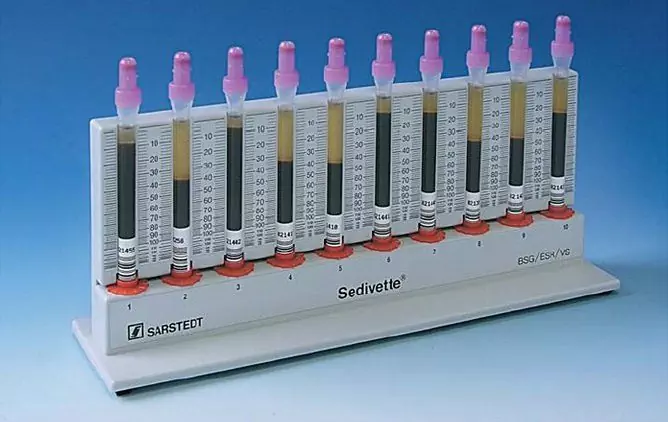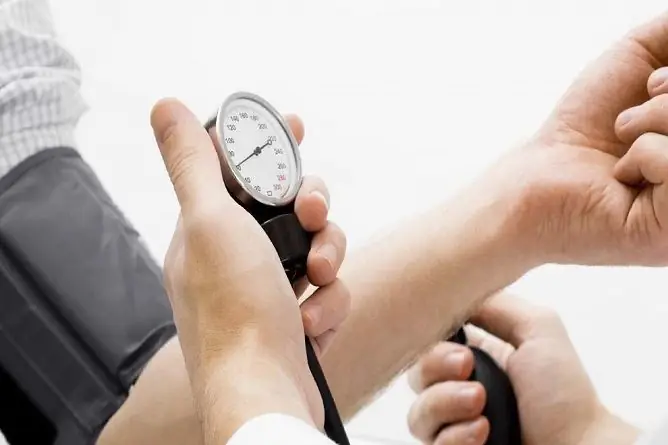- Author Rachel Wainwright [email protected].
- Public 2023-12-15 07:39.
- Last modified 2025-11-02 20:14.
The norm of cortisol in women and men
The content of the article:
- The rate of cortisol in men and women
- Analysis of cortisol in blood and urine
- Conditions in which cortisol is elevated
- Conditions in which cortisol is low
The norm of cortisol in women and men is practically the same. The secretion of the hormone changes little with age, but is subject to a circadian rhythm. Its maximum concentration in the blood is noted in the morning, and the minimum in the evening.
Cortisol (hydrocortisone) is a steroid hormone produced by the adrenal cortex under the influence of adrenocorticotropic hormone (ACTH). Takes part in the regulation of carbohydrate metabolism in the body, as well as in the development of stress reactions.
The main target cells of cortisol are hepatocytes - liver cells. Due to its lipophilic nature, the hormone easily penetrates through the cell membrane into the cytoplasm and nucleus, where it binds to specific receptors. The hormone-receptor complex activates the transcription of individual sections of DNA, as a result of which glucose synthesis increases in hepatocytes, and its decay decreases in muscles. Also, cortisol contributes to the formation of glycogen stores in the liver. Thus, this hormone helps to preserve the body's energy resources.
In the blood, hydrocortisone is in free form, as well as in the form of compounds with albumin, globulin, in conjunction with erythrocytes. A significant proportion of cortisol binds to transcortin (corticosteroid-binding globulin). The free fraction of the hormone, which is 5-10% of the total amount of cortisol, has biological activity. In the bound state, the hormone loses its biological activity. Cortisol is metabolized in the liver, filtered in the renal glomeruli, and excreted in urine when free.

Cortisol, or hydrocortisone, is the so-called stress hormone that is responsible for the body's defenses in the event of an external threat
Hydrocortisone forms the body's defenses against external threats and stressful situations. It helps to increase blood pressure (but does not allow critical changes), increased heart rate, urine output and gastric acid secretion. An increase in the concentration of cortisol in the blood according to the principle of negative feedback reduces the production of corticoliberin, as well as adrenocorticotropic hormone. If necessary, cortisol activates the muscles, reducing the consumption of glucose in the latter. In addition, it reduces the number of leukocytes circulating in the peripheral blood, regulates protein biosynthesis (inhibits in muscle, connective, adipose and bone tissues, and stimulates in the liver).
To normalize the concentration of cortisol in the blood, it is recommended to correct excess weight, stop drinking coffee and alcoholic beverages, and regularly include a sufficient amount of protein foods in the diet. In addition, a full night's sleep is required. The stabilization of cortisol levels in women after childbirth or discontinuation of oral contraceptives occurs within about six weeks.
The rate of cortisol in men and women
The norms of cortisol in the blood depending on the time of day are presented in the table, however, it should be borne in mind that they may differ in different laboratories.
Table. The rate of cortisol in the blood in women and men
| Time | Reference values, μg / dl |
| 07: 00-09: 00 | 4.3-22.4 |
| 15: 00-17: 00 | 3.09-16.66 |
The norm of cortisol in urine (daily) is 58-403 mcg / 24 h.
Deviation from the norm of cortisol affects metabolic processes, in particular, disrupts the water-salt balance, becomes the cause of hypernatremia (a life-threatening condition in which dehydration of the body occurs against the background of excessive sodium retention in the body), potassium deficiency, leads to arterial hypertension, increases the risk of developing heart failure, myocardial infarction.
The daily rhythm of cortisol secretion is disturbed in patients with Itsenko-Cushing's syndrome and in women during pregnancy.
Analysis of cortisol in blood and urine
The concentration of hydrocortisone is determined by examining the blood, urine, and (much less often) the patient's saliva.
Due to the presence of daily fluctuations in the hormone, it is recommended to take blood for analysis in the morning (from 07:00 to 10:00) on an empty stomach or in the afternoon, while at least 8 hours should have passed since the last meal. The day before the analysis, it is necessary to avoid mental and emotional overstrain, physical exertion, to refuse the use of alcoholic beverages and fatty foods. On the day of the study, you should stop smoking, for 30 minutes before blood sampling, the patient should be in complete rest.
If it is necessary to study the concentration of hydrocortisone in dynamics, a series of repeated tests is carried out, and blood sampling for each study should be done at approximately the same time.
In some cases, stress tests with dexamethasone are performed. At the same time, 1-2 days before taking blood, the patient is prescribed hormonal drugs that reduce the production of cortisol.
To determine the cortisol content in urine, it is necessary to collect daily urine. Before conducting the study, you should consult with your doctor about the need to discontinue the drugs taken in order to avoid their influence on the study result. Usually it is required to exclude the intake of estrogens, opiates, synthetic analogs of glucocorticoids, oral contraceptives. When collecting material for research, the first portion of morning urine is released into the toilet, all subsequent urine per day (including morning urine of the next day) is collected in a clean container for collecting urine with a preservative. During the entire collection period, the container is stored in a cool, dark place.
A cortisol test is prescribed in the following cases:
- suspicion of a neoplasm producing adrenocorticotropic hormone;
- osteoporosis;
- high blood pressure;
- significant change in body weight for no apparent reason;
- the appearance of stretch marks on the skin;
- abnormal skin pigmentation;
- premature puberty;
- excess hair growth on the face and body in women in the male pattern (hirsutism);
- infertility;
- menstrual irregularities;
- recurrent candidiasis.
In addition, the determination of the level of cortisol is prescribed to monitor the treatment of adrenal diseases, especially in the case of taking glucocorticoid hormones.
Conditions in which cortisol is elevated
An increased concentration of cortisol in the blood is observed in the following pathological conditions:
- Itsenko-Cushing's syndrome;
- obesity;
- benign or malignant neoplasms of the adrenal glands;
- syndrome of ectopic secretion of adrenocorticotropic hormone;
- acquired immunodeficiency syndrome;
- infectious diseases;
- cirrhosis of the liver;
- hypo- or hyperthyroidism;
- extensive injuries;
- some surgical interventions;
- chronic or one-time severe stress;
- alcoholism.
The concentration of hydrocortisone is increased in women during pregnancy (in the third trimester, the level of the hormone is 2-5 times higher than pre-pregnancy indicators).
Under stress, the amount of the hormone in the blood can increase up to six times the normal cortisol at rest. This excess is physiological and does not pose a threat to health, since already 1.5-2 hours after a nervous shock, the concentration of the hormone normalizes.

Blood cortisol levels can increase sixfold under severe stress
A persistently elevated level of hydrocortisone often indicates the presence of a neoplasm in the brain. With the formation of a pituitary tumor, the production of adrenocorticotropic hormone increases, which, in turn, leads to an increase in the production of cortisol.
In children, an increased level of cortisol can be assumed with premature puberty (both in boys and girls), high blood glucose levels, lack of potassium, slow healing of skin lesions, frequent and unreasonable appearance of edema and / or bruising.
Conditions in which cortisol is low
A decrease in cortisol concentration is observed in the following situations:
- hypopituitarism (decrease or cessation of the production of hormones by the pituitary gland);
- Addison's disease (chronic insufficiency of the adrenal cortex);
- congenital insufficiency of the adrenal cortex;
- adrenogenital syndrome;
- hepatitis, liver cirrhosis;
- significant weight loss for no apparent reason;
- taking a number of drugs (especially barbiturates), as well as with a sharp withdrawal of glucocorticoids after their prolonged use.
Signs that the level of cortisol in the blood is below normal are rapid fatigue, increasing weakness, impaired appetite, and a decrease in blood pressure.
YouTube video related to the article:

Anna Aksenova Medical journalist About the author
Education: 2004-2007 "First Kiev Medical College" specialty "Laboratory Diagnostics".
Found a mistake in the text? Select it and press Ctrl + Enter.






